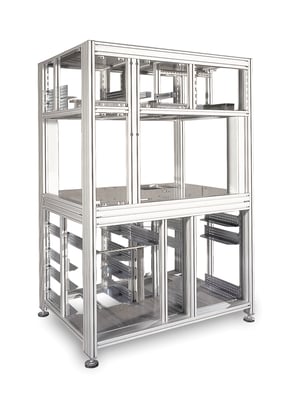
Thousands of workplace accidents are reported annually, with one of the leading causes being loss of control over machinery, equipment, or tools. Machine and process operators are among the most at-risk occupational groups. Many accidents occur when individuals become trapped or crushed in or between robots, conveyor belts or various types of machines. However, using the proper protective equipment can significantly reduce the risk of such incidents.
Occupational safety
Some of the most common risks when working with machines are personnel coming in contact with moving machine parts and cutting tools, or that material/tool parts are thrown out of the machine. A machine guard effectively protects the operator against this type of danger. Sometimes safety light curtains or light bars can be sufficient protection. However, they provide no physical barrier, usually only the power to the machine is turned off if someone or something breaks the light beam. A machine guard made of aluminium profiles and various types of panels effectively protects both personnel and the surroundings.
Protection against pollution
Something that perhaps rarely comes to mind when discussing machine guarding is protection of what is inside the machine rather than the surrounding environment. By building a tightly sealed machine guard, sensitive components and equipment can be kept free from e.g. dirt and dust. The machine is still accessible for service and maintenance through hatches and doors, and cables and wires are safely stored in cable ducts. Most often are, e.g. filling machines and machines in the food industry already encapsulated to protect what is produced.
Machine guarding can be designed in different ways and the possibilities are endless. Here are some examples of special guarding.
Enclosures for vision systems
An example of guarding/shielding intended to protect what is inside are enclosures for machine vision cameras. These enclosures are often placed over belt conveyors. The enclosure has completely tight walls, often made of sheet metal, and sealings that effectively shut out all light. In the enclosure, there is a camera and dedicated light source that identifies the location of the objects on the belt so that, for example, a robot can pick them up. The vision system can also adjust the speed of the process and optimize the robot's operation.
Guarding for lasers
In special production facilities, laser shielding may be necessary. This is to protect people and the environment from laser exposure. In these cases, it is especially important that all walls and all materials withstand a certain period of exposure without the laser cutting through. This type of enclosure may require double-wall construction, laser-proof vents and exhaust, piping and cable entry systems, and other specially designed components.

